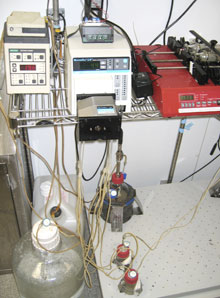High-Speed Evolution Aids Drug Development
By exploiting the rapid replicating power of viruses, researchers were able to make biological molecules in the laboratory evolve much more rapidly than they can with existing approaches. Their new method, called phage-assisted continuous evolution (PACE), could be used to accelerate the development of therapeutic proteins, such as new cancer drugs, or to tackle unsolved questions about how evolution works.

Most traditional pharmaceutical agents are small molecules, but a number of promising new therapies are based on macromolecules, such as proteins. So-called “directed evolution” gives scientists a way to adapt a naturally occurring macromolecule to perform a specific therapeutically useful function, such as bind to a cancer-linked protein.
“For some applications, the speed of conventional protein evolution is a bottleneck,” says David Liu, a professor of chemistry and chemical biology at Harvard University and senior author of a paper describing the new technique in Nature. “Efforts to create proteins with tailor-made properties will be maximally useful if methods to create them can operate on a truly practical timescale.”
To streamline this undertaking, Liu and then-graduate students Kevin Esvelt and Jacob Carlson harnessed the life cycle of the M13 bacteriophage, a virus that infects E. coli. In the traditional method of directed evolution, scientists use an error-prone DNA copying method to create a library of genes encoding proteins with slightly different functions. With PACE, viruses carrying a gene for the target protein automatically generate such a library when they replicate inside E. coli cells, which have been modified to increase the viruses’ mutation rate.
The new method also eliminates the cumbersome need for scientists to screen the entire library for successful variants during each round of evolution. PACE links the desired function to the production of a substance that the virus can’t thrive without. If a single virus comes up with a version of the target protein that performs the desired function, that virus can complete its life cycle—which means its offspring will go on to infect other E. coli and continue the cycle. Subsequent rounds of evolution progress continually, automatically, and—because M13 has a life cycle of just 10 minutes—extremely quickly.
As a result, scientists could generate an enzyme with a tailor-made target activity in a single week—through as many as 200 rounds of protein evolution—a feat that Liu says might have taken years with conventional methods.
Liu and his colleagues developed PACE with accessibility in mind; the system can be built from readily available components. He believes it could one day be used to rapidly evolve highly potent and specific therapeutic antibodies—a promising new treatment avenue for cancer and autoimmune diseases. While current directed evolution methods are capable of producing such molecules, they are sometimes prohibitively time-consuming and expensive.
And it also opens the door to addressing some long-standing basic questions about how molecular evolution works. With the PACE setup, researchers can simultaneously run the same evolutionary experiment many times and for many generations, investigating whether a particular protein will always follow the same evolutionary trajectory under a given set of conditions. With conventional methods, this kind of investigation might take decades; with PACE, it can be done in two weeks. “To me, it’s extremely interesting to be able to do experiments like that,” says Frances Arnold, a professor of chemical engineering, bioengineering, and biochemistry at Caltech. “It leaves me eager to see the results.” Arnold was not involved in the study.
She cautions, however, that certain macromolecules won’t be amenable to the new approach. For a protein or nucleic acid to be a target for PACE, it needs to be linkable to the survival of the virus. Because of this quirk, says Arnold, the system’s practical utility is somewhat limited—it couldn’t, for example, design an enzyme for use in biofuel production. Nonetheless, says Arnold, “it’s a very clever application to do continuous evolution of a limited set of proteins.”
Keep Reading
Most Popular
Large language models can do jaw-dropping things. But nobody knows exactly why.
And that's a problem. Figuring it out is one of the biggest scientific puzzles of our time and a crucial step towards controlling more powerful future models.
How scientists traced a mysterious covid case back to six toilets
When wastewater surveillance turns into a hunt for a single infected individual, the ethics get tricky.
The problem with plug-in hybrids? Their drivers.
Plug-in hybrids are often sold as a transition to EVs, but new data from Europe shows we’re still underestimating the emissions they produce.
Stay connected
Get the latest updates from
MIT Technology Review
Discover special offers, top stories, upcoming events, and more.